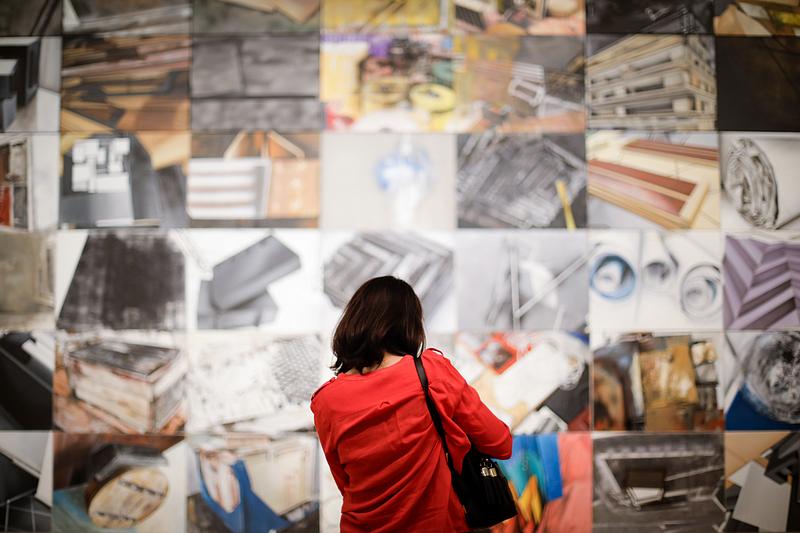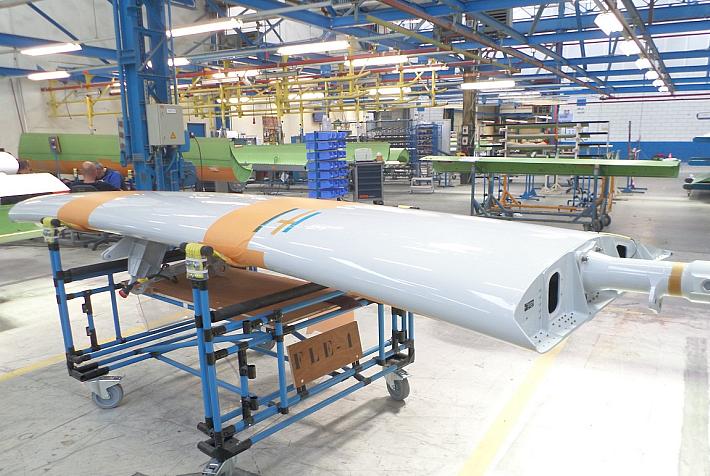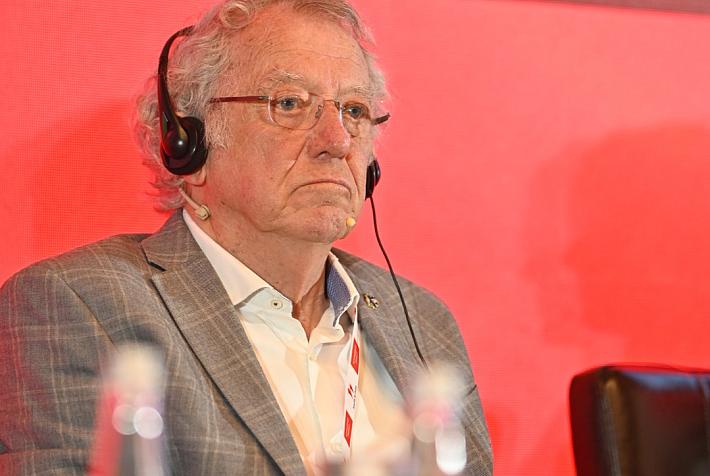Bucharest exhibitions: What’s on show in the city

We outline some of the exhibitions currently open in Bucharest, from contemporary Romanian art to photography and Japanese prints.
Laboratory II. 1989 – The Restoration of Shot Paintings
The building of the National Museum of Art of Romania, which sits across the street from the former HQ of the Communist Party’s Central Committee, now hosting the Interior Affairs Ministry, was severely damaged during the December 1989 Revolution. With it, more than 1,000 artworks were damaged or destroyed, many of them part of the museum’s permanent exhibition at the time.
Now, this exhibition showcases works that underwent restoration and the history of the museum’s restoration lab, destroyed during the 1989 events, and the laborious process of recovering a number of paintings from MNAR’s collections. Out of the 47 restored works, the public can see 20 paintings, three of them exhibited for the first time in the last three years: Plopi la marginea satului (Poplars at the outskirts of the village) by Ioan Andreescu (1851 – 1882), Vânat (Game) and Natură statică (Still Life) by Sava Henţia (1848 – 1904). The paintings were part of the museum’s permanent exhibition at the time and were severely damaged during the Revolution.
Where: The National Museum of Art of Romania (MNAR); open until March 28. More details here.
Piranesi. Architectures and Ghosts – anniversary exhibition
This exhibition is dedicated to artist Giovanni Battista Piranesi (1720 – 1778), marking 300 years since his birth and celebrating the work of the archaeologist, architect, artist, collector, and scholar who shaped the European imaginary of Rome. It showcases a selection of 39 etchings by Piranesi grouped in three series: Grotteschi, Carceri d’invenzione, and Vedute di Roma. These are accompanied by 13 drawings and etchings made by a group of European artists active in the 18th century, such as Gaspar van Wittel, Giandomenico Tiepolo, Antonio Canaletto, Hubert Robert, Edmé Bouchardon, and Francisco de Goya. All of the 52 works are part of MNAR’s patrimony.
Where: The National Museum of Art of Romania (MNAR); open until March 28. More details here.
Out of the Blue
Din senin/ Out of the Blue is an exhibition put together after the Museum of Recent Art (MARe) undertook last year a campaign to purchase contemporary Romanian art. Over the last four to five years, MARe has constantly added works to its collection, and last year more than 600 artists responded to its call for works, showing the “unprecedented enthusiasm of the artistic world in Romania,” Erwin Kessler, the museum’s director explains in a presentation of the exhibition.
The exhibition covers 61 works by 45 contemporary Romanian artists: Olimpiu Bandalac, Dan Basu, Michele Bressan, Titi Ceară, Codruța Cernea, Traian Cherecheș, Tudor Ciurescu, Elena Copuzeanu, Doru Covrig, Alina Crasovschi Feneș, Tudor Crîșmăriuc, Cristian Dițoiu, Daniel Djamo, Florina Drăguș, Arantxa Etcheverria, Norbert Filep, Dimitrie Luca Gora, Vasile Gorduz, Dumitru Gorzo, Teodor Graur, Lucian Hrisav, Gheorghe Ilea, Nona Inescu, Regina Ionescu, Makkai István, Marius Leonte, Maxim Liulca, Cristian Macovei, Micleușanu M., Cosmin Moldovan, Grupul Monotremu, Vlad Nancă, Ocu, Pandele Pandele, Alexandru Papuc, Neculai Păduraru, Alexandru Păsat, Alexandru Rădulescu, Alexandru Răduță, Larisa Sitar, Ștefan Tănase, Ionuț Vancea, Naiana Vatavu, Bogdan Vlăduță, Kristin Wenzel, Kero Zen.
Where: The Museum of Recent Art (MARe), until February 28. More details here.
12 Years After. A Survey of Romanian Art in 180 works
This exhibition comes after the acquisition campaign rolled out by the Contemporary Art Museum MNAC last year, the first one in the last 12 years, and aimed at living visual artists from Romania, active within the country and abroad. “Its role was to provide an incentive for current artistic production and to increase the Romanian cultural heritage managed by the MNAC collection.” The museum purchased a total of 167 works and also received 13 donations. Of the purchased work, 40 belong to women.
Where: The National Museum of Contemporary Art (MNAC), until March 28. More details here.
Mon Cabaret Noir – photography exhibition
Occasioned by the premier of the performance Maria de Buenos Aires, tango opera with music by Astor Piazzolla staged by Răzvan Mazilu at Teatrelli, this exhibition captures a bit of the performance’s atmosphere while referencing the world of Berlin’s cabaret scene of the 1920s. The photographs in the exhibition are by Mihaela Tulea, Florin Bondrilă, and Dragoș Toader.
Where: CREART Gallery, until March 14. More details here.
Romania Raw – photography exhibition
The exhibition covers a series of works by Miron Zownir, showcasing “in an uncensored manner aspects of troubling realities of today’s Romania.” Zownir was an invited artist of the residence organized by Visual Kontakt gallery and the German Cultural Center in Cluj in 2018. During his time in the country, he came into contact with the Roma community in Pata Rât, the underground life, or the underprivileged communities in Cluj, București, Timișoara, and Baia-Mare.
Where: Goethe Institute, March 1-21. More details here.
Celebrities of the Floating World – Japanese prints
This exhibition of Japanese prints showcases 200 items created between 1603 and 1868 - known as the Edo era. The works, part of the private Ukiyo-e collection of George Șerban, cover topics such as history, Kabuki Theater, erotic art, or landscapes. The exhibition includes works by Hishikawa Moronobu (1618-1694), Okumura Masanobu (1686-1764), Suzuki Harunobu (1724-1770), Isoda Koryusai (1735-1790), Katsushika Hokusai (1760-1849), Keisai Eisen (1790-1848), Kikukawa Eizan (1787-1867) and more, as well as Hokusai, Eisen, Harunobu and Kunisada books, made during the 19th century.
Where: The National Museum of Romanian Literature, until April 10. More details here.
Reptilia
This temporary exhibition of live reptiles is meant to bring visitors face to face with a range of reptiles from various places. Among the creatures the public is invited to see are the black mamba, rinkhals or the ring-necked spitting cobra, the Gaboon viper, the reticulated python, or the anaconda. Visitors more details on their habits, how they adapt to their surrounding environment, and the role they play in the ecosystem. Besides the living creatures, the exhibition also includes many specimens from the collections of the Grigore Antipa Natural History Museum.
Where: Grigore Antipa Natural History Museum, until June 16. More details here.
Biking through other times
Among the many thematic exhibitions organized by the Bucharest Municipality Museum, this one looks at the history of the bicycle. Hosted at the Suțu Palace, the exhibition will showcase lesser-known aspects of this vehicle, tracing its history and evolution in time, from the 1818 wooden “running machine” that had no brakes or pedals, to the velocipede, and the various improvements that took the bicycle to its current form, the exhibition makes use of the museum’s photography collection to highlight novel images, as well as rare exhibits.
Where: Bucharest Municipality Museum, Suțu Palace, March 5 – May 30. More details here.
Ancient jewelry and relevant messages
This exhibition showcases a variety of jewelry items from the archeology collections of the Bucharest Municipality Museum to “explore people’s complex relationship with jewelry and take visitors to a world whose art still fascinates today.” Made from various materials, from shells and bone to stone, clay, metal, glass, or semi-precious stones, the items attest to the need to embellish the body, the hair, or the clothes, showcasing the creativity put into designing them across the ages.
Where: Bucharest Municipality Museum, Casa Filipescu-Cesianu, until March 20. More details here.
The full list of the temporary exhibitions of the Bucharest Municipality Museum is available here.
Fragment. The Experience of Restoration
This exhibition aims to take visitors into the world of patrimony restoration by unveiling how museum items reach new stages of their existence. The public can discover a variety of restored items and the stories they tell, some of them on display for the first time, others that are part of the museum’s core collection. Among the items included are ancient books, such as the 1693 Greek-Romanian Gospel book published by Antim Ivireanul or a decree issued by ruler Ștefan cel Mare in November 1493. Also included in the exhibition are a variety of bronze and iron items discovered during archeological works carried out all over the country, dating back to the Neolithic, the Bronze and Iron Age, but also to the Greek, Roman, and Byzantine periods and the Middle Ages, paintings with historical themes by Nicolae Tonitza or Ştefan Luchian, fresco fragments, or various textiles, including the Liturgical Banner of Ștefan cel Mare and a dress that belonged to Queen Marie of Romania.
Where: The National Museum of History of Romania (MNIR), until May. More details here.
Birds. An Homage to Brâncuși
The exhibition traces the motif of the bird, that sculptor Constantin Brâncuși captured in well-known works such as Măiastra or Bird in Space, in a variety of items from the Village Museum’s collection - icons, crosses, carpets, towels, clothing items, household items, engravings, or toys.
Where: Dimitrie Gusti National Village Museum, until March 28. More details here.
Romanian Kitsch Museum
Romanian Kitsch Museum offers an exhibition that is meant to evoke a feeling of nostalgia for the recent past through concepts, items, and decorations typical of the 1980s-1990s. The items are grouped into eight sections: Dracula, religious kitsch, communist kitsch, interior design, gypsy kitsch, modern kitsch, kitsch art gallery, and make your own kitsch, with exhibits ranging from 3D icons to statues of Ceaușescu or images of Gioconda or Che Guevara reproduced on a variety of surfaces, from socks to bath tiles.
Where: AFI Palace Cotroceni, until April 6. More details here.
AFI Cotroceni also hosts the Museum of Senses, encompassing more than 40 different exhibits allowing visitors to experiment with visual illusions and challenge their perception. For instance, the infinity room lets those who walk in get carried away in a waltz of lights and reflections, while in the inverted room, they can walk, or not, on the ceiling. They can also try the bed of nails or the kaleidoscope that will create a work of art using their face, among many others.
Where: AFI Palace Cotroceni, open every day.
(Photo: Cateyeperspective | Dreamstime.com)
simona@romania-insider.com
















